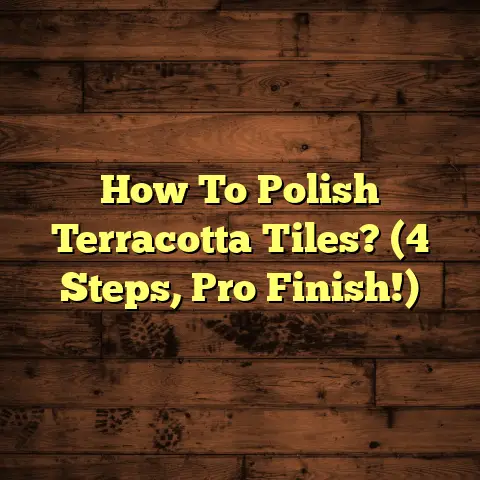Remove Cement From Tile? (4 Pro Secrets!)
I’ve been in the flooring game for over 15 years, and let me tell you, I’ve seen it all.
From the resurgence of classic subway tile in kitchens to the explosion of large-format porcelain in bathrooms, tiles are hotter than ever.
And I get it! They’re durable, stylish, and can completely transform a space.
But with great tile comes great responsibility… like dealing with that pesky cement residue after installation.
That thin film, or even worse, chunks of dried mortar or grout, can really ruin the final look.
Trust me, I’ve seen homeowners driven to the brink of madness trying to scrub it off with every cleaner under the sun.
The good news?
It doesn’t have to be a nightmare!
Over the years, I’ve developed some tried-and-true methods for tackling this issue, and I’m excited to share them with you.
Forget those harsh chemicals and endless scrubbing.
I’m going to let you in on four pro secrets that will help you get your tiles sparkling clean, without damaging them.
We’ll cover everything from natural remedies to specialized tools, so you can choose the best approach for your specific situation.
Ready to learn how to banish that cement residue for good?
Let’s dive in!
Section 1: Understanding Cement Residue on Tiles
So, what exactly is this cement residue we’re battling?
Well, it’s essentially the leftover bits of cement-based materials used during tile installation.
This can include:
- Mortar: The adhesive that holds the tiles to the subfloor or wall.
- Grout: The filler that seals the spaces between the tiles.
- Thin-set: Another type of adhesive, often used for thinner tiles.
During installation, it’s almost impossible to avoid getting some of this material on the tile surface.
Sometimes it’s a thin haze, other times it’s blobs and smears.
If not cleaned up properly, it hardens and becomes a real pain to remove.
Why is it so important to get rid of it?
Aesthetics, for sure!
Cement residue can dull the tile’s finish, obscure its color, and generally make the whole installation look unprofessional.
But it’s not just about looks.
Residue can also affect the tile’s functionality.
For example, it can:
- Make the surface more difficult to clean.
- Create a breeding ground for mold and mildew.
- Even contribute to the breakdown of the grout over time.
I’ve seen cases where homeowners ignored the residue, and years later, they were dealing with stained, grimy tiles that were impossible to restore.
Don’t let that be you!
Now, there are a lot of misconceptions about cement removal.
Many people think that a simple wipe-down with soap and water will do the trick.
Unfortunately, that’s rarely the case.
Cement residue is alkaline, meaning it’s resistant to most common household cleaners, which are typically neutral or acidic.
Plus, the hardened cement particles can be quite stubborn, requiring a more aggressive approach.
That’s where my pro secrets come in.
Section 2: Pro Secret #1 – The Power of Vinegar and Water
Okay, let’s start with a natural and often surprisingly effective solution: vinegar and water.
I know, it sounds too simple, right?
But trust me, vinegar’s mild acidity can work wonders on cement residue, especially if it’s not too thick or hardened.
Here’s why it works:
Vinegar contains acetic acid, which reacts with the alkaline components of cement, helping to dissolve and loosen the residue.
Plus, it’s a readily available, affordable, and eco-friendly option.
Here’s my step-by-step guide for using vinegar and water to remove cement residue:
Mix your solution: The ideal ratio is usually 1 part white vinegar to 1 part water.
For tougher residue, you can increase the vinegar concentration, but always test on an inconspicuous area first to ensure it doesn’t damage the tile.Apply the solution: Use a sponge or cloth to liberally apply the vinegar solution to the affected areas.
Make sure the residue is thoroughly saturated.Let it soak: This is crucial!
Give the vinegar time to work its magic.
I usually recommend letting it soak for at least 15-20 minutes.
For stubborn residue, you can even let it sit for an hour, but keep an eye on it to make sure it doesn’t dry out.Scrub, scrub, scrub: After soaking, use a non-abrasive scrubbing pad or brush to gently scrub the residue.
You might need to apply some elbow grease, but avoid using anything too harsh that could scratch the tile surface.-
Rinse thoroughly: Once you’ve scrubbed away the residue, rinse the area thoroughly with clean water to remove any remaining vinegar and loosened cement particles.
Dry and inspect: Use a clean cloth to dry the tiles and inspect your work.
If you still see some residue, repeat the process.
Pro Tips:
- For vertical surfaces, like shower walls, you can use a spray bottle to apply the vinegar solution.
- If you’re dealing with a large area, work in sections to prevent the vinegar from drying out.
- For particularly stubborn spots, try making a paste of baking soda and vinegar.
Apply the paste to the residue, let it sit for a few minutes, and then scrub.
Precautions:
- Always test the vinegar solution on an inconspicuous area of the tile before applying it to the entire surface.
- Avoid using vinegar on natural stone tiles like marble or limestone, as the acid can etch and damage the surface.
- Wear gloves to protect your hands from the vinegar.
Personal Story:
I once had a client who had installed beautiful slate tiles in their entryway.
Unfortunately, the contractor had left a significant amount of grout haze on the surface.
They tried everything to remove it, but nothing seemed to work.
Finally, I suggested they try the vinegar and water method.
They were skeptical at first, but after a few applications and some gentle scrubbing, the grout haze disappeared, revealing the natural beauty of the slate.
They were thrilled!
Section 3: Pro Secret #2 – Using a Commercial Cement Remover
Sometimes, vinegar just isn’t enough.
For tougher, more stubborn cement residue, you might need to bring in the big guns: a commercial cement remover.
These products are specifically formulated to dissolve cement-based materials without damaging tile surfaces.
Advantages of using a commercial cement remover:
- Stronger cleaning power than vinegar.
- Designed to be safe for most tile types (but always test first!).
- Often contain additives that help to prevent future staining.
What to look for in a quality product:
- pH-neutral: This is important to avoid damaging sensitive tiles like natural stone.
- Biodegradable: An eco-friendly option that’s better for the environment.
- Specifically formulated for tile: Avoid products that are designed for concrete or other surfaces, as they may be too harsh.
Here’s a comprehensive guide on how to properly apply a commercial remover:
Preparation: Read the product label carefully and follow the manufacturer’s instructions.
Gather your supplies: the cement remover, a bucket of clean water, a sponge or cloth, a scrubbing brush, and protective gear (gloves, eye protection, and possibly a respirator).-
Test: As with vinegar, always test the remover on an inconspicuous area of the tile before applying it to the entire surface.
Application: Apply the remover to the affected areas using a sponge, cloth, or sprayer.
Make sure the residue is thoroughly saturated.Dwell Time: Allow the remover to dwell on the surface for the amount of time specified on the product label.
This is crucial for allowing the chemicals to break down the cement residue.Scrubbing: After the dwell time, use a scrubbing brush or pad to gently scrub the residue.
You may need to apply some pressure, but avoid using anything too abrasive that could scratch the tile.Rinsing: Rinse the area thoroughly with clean water to remove any remaining remover and loosened cement particles.
You may need to rinse multiple times to ensure all traces of the product are gone.Post-Application Cleaning: After rinsing, use a clean cloth to dry the tiles and inspect your work.
If you still see some residue, repeat the process.
Safety Measures:
- Always wear gloves and eye protection when working with commercial cement removers.
- Work in a well-ventilated area to avoid inhaling fumes.
- If you have sensitive skin or respiratory issues, consider wearing a respirator.
- Keep the product out of reach of children and pets.
Product Recommendations:
While I can’t endorse specific brands, I generally recommend looking for products from reputable manufacturers that specialize in tile care.
Read online reviews and ask for recommendations from other professionals.
Example:
I recently used a commercial cement remover to clean up a new bathroom installation where the tiler had left a thick layer of grout haze on the porcelain tiles.
The vinegar method had done almost nothing.
But after applying the commercial remover and following the instructions carefully, the grout haze dissolved easily, leaving the tiles sparkling clean.
The client was amazed at the difference!
Section 4: Pro Secret #3 – Utilizing a Scraper and Heat
Okay, let’s get a little more hands-on.
Sometimes, the cement residue is so thick and hardened that neither vinegar nor commercial removers can fully penetrate it.
In these cases, you might need to resort to mechanical removal using a scraper and heat.
Here’s the basic idea:
The heat softens the cement, making it easier to scrape away without damaging the tile surface.
Types of scrapers that work best:
- Plastic Razor Blade Scrapers: These are ideal for delicate surfaces like glass and polished tile, as they are less likely to scratch.
- Grout Removal Tools: These tools have a specialized blade that is designed to remove grout without damaging the surrounding tiles.
- Putty Knives: These can be used for larger areas of residue, but be careful not to apply too much pressure.
Proper scraping technique to avoid scratching tiles:
- Always hold the scraper at a shallow angle to the tile surface.
- Use gentle, even pressure.
- Avoid digging the scraper into the grout lines.
- Work in small sections.
How to safely apply heat:
- Heat Gun: A heat gun is the most effective way to apply heat, but it can also be dangerous if not used properly.
Always keep the heat gun moving and avoid holding it in one spot for too long. - Hair Dryer: A hair dryer is a safer option, but it may not be as effective for softening the cement.
Step-by-step guide to scraping and heating:
- Prepare the area: Clean the tile surface with a damp cloth to remove any loose debris.
- Apply heat: Use a heat gun or hair dryer to heat the cement residue for a few seconds.
- Scrape: Immediately after heating, use a scraper to gently remove the softened cement.
- Repeat: Repeat the heating and scraping process until all of the residue is removed.
- Clean up: Clean the tile surface with a damp cloth to remove any remaining debris.
Tips for maintaining tile integrity during the scraping process:
- Be patient: Don’t try to remove the residue too quickly, as this can increase the risk of scratching the tile.
- Use the right tools: Make sure you are using the appropriate scraper for the type of tile you are working with.
- Practice on a hidden area: Before you start scraping, practice on a hidden area of the tile to get a feel for the process.
Example:
I once had to remove a large patch of hardened mortar from a set of hand-painted ceramic tiles.
I was terrified of damaging the delicate surface.
But by using a plastic razor blade scraper and a heat gun on a low setting, I was able to carefully remove the mortar without scratching the tiles.
It took a lot of time and patience, but the end result was worth it.
Section 5: Pro Secret #4 – Professional Help
Let’s be real – sometimes, DIY just isn’t the answer.
There are situations where hiring a professional tile cleaner is the best, or even the only, option for removing cement from your tiles.
Here are some scenarios where professional help is recommended:
- Extensive Damage: If the cement residue covers a large area or is deeply embedded in the tile, it may be too difficult to remove on your own.
- Delicate Tiles: If you have delicate tiles like natural stone, glass, or hand-painted ceramic, you may want to leave the cleaning to the professionals to avoid damaging them.
- Lack of Experience: If you’re not comfortable using power tools or handling chemicals, it’s best to hire a professional.
- Time Constraints: If you don’t have the time or energy to tackle the job yourself, a professional can get it done quickly and efficiently.
Benefits of professional services:
- Expertise: Professionals have the knowledge and experience to safely and effectively remove cement from all types of tiles.
- Specialized Equipment: Professionals have access to specialized equipment like high-pressure cleaners, steam cleaners, and industrial-strength chemicals.
- Insurance: Professionals are insured, so you’re protected in case anything goes wrong.
What to expect when hiring a professional:
- Consultation: The professional will inspect the area and provide you with a free estimate.
- Preparation: The professional will prepare the area by covering surrounding surfaces and protecting your belongings.
- Cleaning: The professional will use specialized equipment and chemicals to remove the cement residue.
- Rinsing and Drying: The professional will rinse and dry the tiles thoroughly.
- Sealing (Optional): The professional may recommend sealing the tiles to protect them from future staining.
How to choose a reputable service:
- Get Referrals: Ask friends, family, or neighbors for recommendations.
- Read Online Reviews: Check online reviews to see what other customers have to say about the company.
- Check Credentials: Make sure the company is licensed and insured.
- Get Multiple Estimates: Get estimates from several different companies before making a decision.
- Ask Questions: Don’t be afraid to ask questions about the company’s experience, methods, and guarantees.
Testimonials/Case Studies:
I recently worked with a homeowner who had installed beautiful marble tiles in their bathroom.
Unfortunately, the contractor had used the wrong type of grout, which caused a stubborn haze to form on the surface.
They tried everything to remove it, but nothing seemed to work.
Finally, they called me in.
I used a specialized marble cleaner and a gentle polishing pad to remove the haze without damaging the delicate surface.
The homeowner was thrilled with the results.
Another Example:
I had a client who had tried to remove cement from their tile themselves and ended up scratching the surface.
They called me in to repair the damage.
I used a series of polishing compounds to buff out the scratches and restore the tile to its original condition.
They were so relieved that I was able to fix their mistake.
Conclusion
So there you have it – my four pro secrets for removing cement from tile!
Whether you choose to tackle the job yourself or hire a professional, I hope this article has given you the knowledge and confidence you need to get your tiles sparkling clean.
Remember, removing cement residue is crucial for maintaining the beauty and integrity of your tiles.
Don’t let that unsightly film ruin your hard work and investment.
Take action today and enjoy your beautiful, clean tiles for years to come!
And hey, if you’re in my area and need a hand, don’t hesitate to reach out.
I’m always happy to help!





